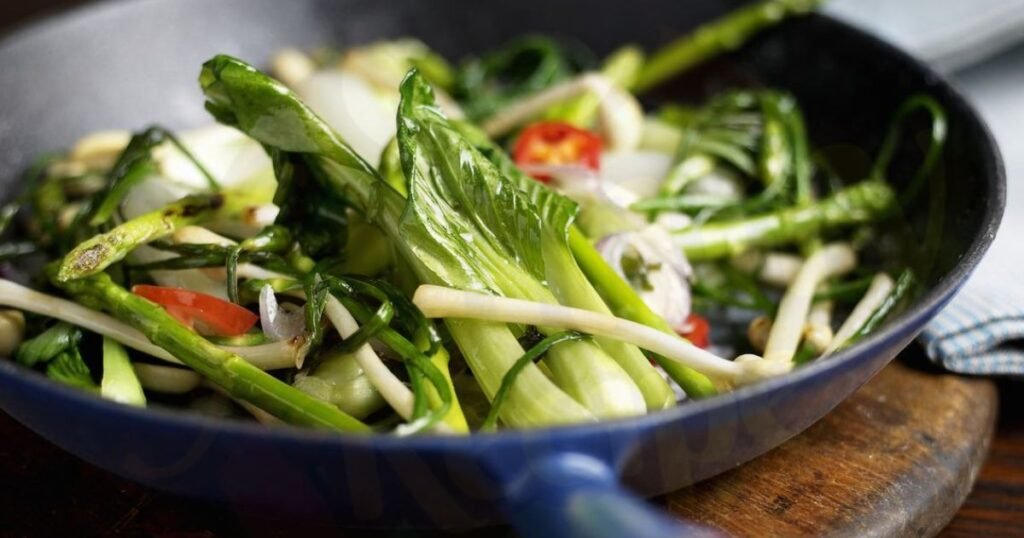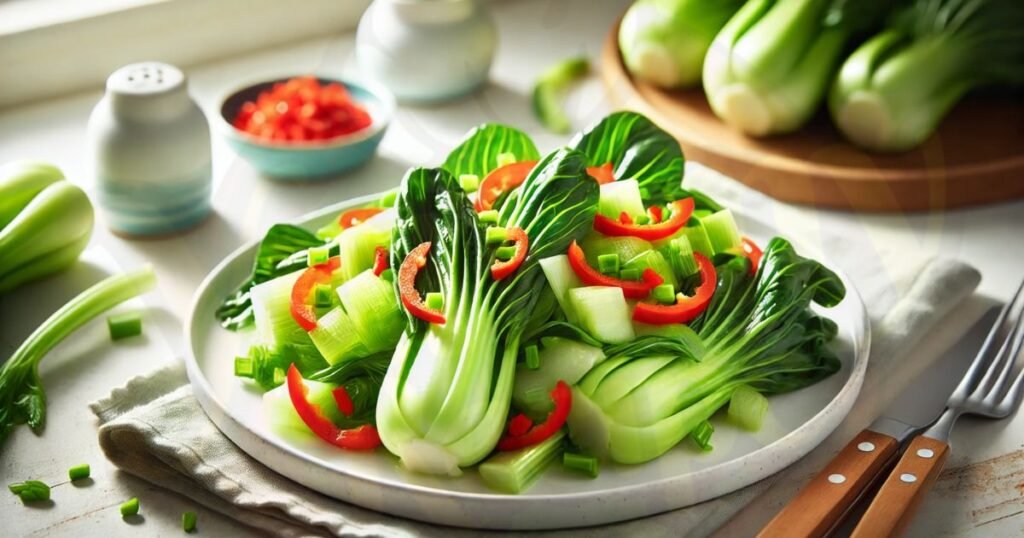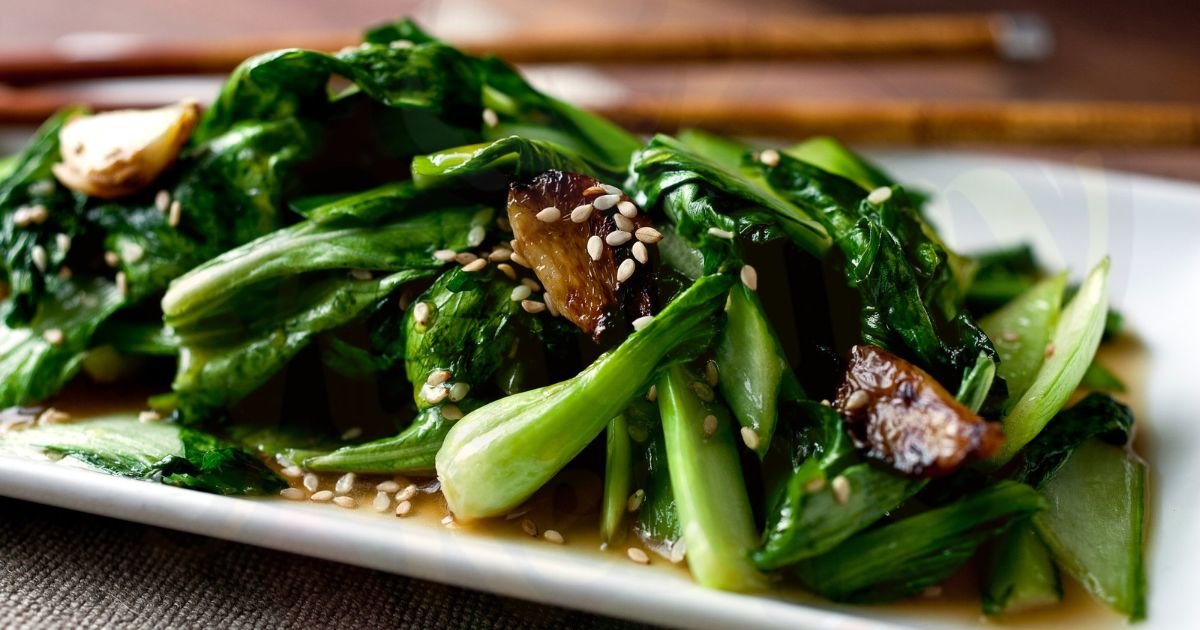Celery, Bok Choy, and Spinach are majors in a healthy kitchen. These adjustable greens can transform any dish. Each brings a unique texture and flavor profile to the table. It has become a favorite among chefs and home cooks as well. These leafy vegetables are perfect to boost their nutritional value.
The culinary possibilities of Celery, Bok Choy, and Spinach provide a lot of flavors and health benefits. They can be combined in countless ways to create dishes.
Nutritional Benefits
Celery is low in calories but high in fiber and water. It makes it ideal for weight management and hydration. Bok choy is rich in vitamins A, C, and K, and minerals like calcium and selenium. Spinach contains iron, magnesium, and folate, needed for blood health and energy levels. These greens form a powerhouse of nutrition that supports overall health.
Historical Origins
Celery originated in the Mediterranean regions and parts of the Middle East. Bok choy comes from China, where it has been a diet staple for over 5,000 years, prized for its versatility and nutritional profile. Spinach is believed to have originated in ancient Persia before spreading into China. After some time, it became popular in Europe.
Popular Culinary Uses
Celery is in the flavor bases of various cuisines, including the French mirepoix and the Italian soffritto. Bok choy shines in Asian cuisine, in soups and stir-fries. Spinach is featured in everything from Indian palak paneer to Italian pasta dishes and American smoothies.
Essential Ingredients
Select the freshest greens and measure them for perfect balance. Identify suitable substitutes to cater to various dietary needs. Ensure that every component contributes to a healthy meal.
Freshness Indicators
Choosing fresh vegetables is crucial for taste and nutrition.
- Celery
Leaves should be crispy and bright green
- Spinach
Leaves that are deep green with no signs of wilting
- Bok Choy
Fresh bok choy has vibrant leaves and stalks that feel solid

Recommended Quantities
The right proportions can enhance the flavors of your dish.
- Celery
2 cups chopped
- Spinach
2 cups of packed leaves
- Bok Choy
1 to 2 heads of bok choy
Substitute Ingredients
If you’re cooking for someone with food allergies, here are some safe alternatives:
- Kale or Arugula
They make great substitutes for Spinach
- Swiss Chard or Napa Cabbage
They can replace bok choy, offering a similar texture
- Cucumber or Water Chestnuts
Use these instead of Celery to achieve a similar crunch

Kitchen Equipment Needed
The right tools can make the cooking process smoother and safer.
Required Tools
Here are some essential tools you will need:
- Chef’s Knife
- Skillet or Wok
- Cutting Board
- Measuring Cups and Spoons
Safety Measures While Cooking
Here are some safety tips to follow:
- Handle with Care
Always use oven mitts when handling hot pans or pots
- Avoid Contamination
Use separate cutting boards for vegetables and raw meats
- Keep a Clean Workspace
Ensure your cooking area is clean and uncluttered to avoid accidents
Step-by-Step Cooking Guide
Use the best cooking techniques to enhance flavor and make necessary adjustments for different altitudes.
Prepare the Ingredients
Here’s how to get your vegetables ready:
- Wash Thoroughly
Rinse celery, bok choy, and spinach under cold water to remove any dirt or chemicals
- Chop Uniformly
Cut celery and bok choy into similar-sized pieces to ensure even cooking
- Dry Off
Pat the greens dry with a clean towel to remove excess moisture
Cooking Techniques
Sautéing the vegetables quickly in a hot pan with a bit of oil helps achieve slight caramelization, adding depth to the dish. Adding herbs and spices early in the cooking process allows the flavors to meld beautifully with the greens, which enhances the overall taste of the dish.

Cooking at Higher Altitudes
Here are a couple of adjustments to consider:
- Increase Cooking Time
At higher altitudes, water boils at a lower temperature, which means cooking times may need to be extended
- Adjust Seasonings
Flavors can be muted at higher elevations, so you may need to season your dish more aggressively
Flavor Enhancements
Different spices and cooking methods can introduce a new depth of flavor.
Herbs and Spices
Transform your dish from simple to spectacular with:
- Chili Flakes
- Sesame Seeds
- Garlic and Ginger
Cooking Methods
Here’s a quick comparison:
| Cooking Method | Texture | Flavor Intensity | Nutritional Preservation |
| Steaming | Softer, more tender | Milder | Higher preservation of vitamins and minerals |
| Sautéing | Crispier, slightly browned | More robust, caramelized flavors | Some nutrient loss due to high heat |
Vegan and Gluten-Free Variations
This recipe is naturally vegan and an excellent choice for those with dietary restrictions. To enhance its appeal, consider incorporating vegan protein sources like tofu or tempeh for a heartier dish. For an extra layer of flavor, a splash of gluten-free tamari or coconut aminos can be used in place of soy sauce.
Serving and Presentation Tips
The final touches in serving and presentation can greatly enhance the dining experience. It makes your dish not only delicious but also visually appealing.
Plating Techniques
Here are a few presentation techniques to make your dish look as good as it tastes:
- Layering
Spinach at the base, topped with bok choy, and finally celery
- Garnishing
Add fresh herbs like cilantro or parsley, or a drizzle of sesame oil
- Color Contrast
Arrange the greens against a backdrop of bright vegetables like carrots or redbell

Pairing with Side Dishes
This leafy green dish pairs wonderfully with a variety of side options that complement its texture and enhance its nutritional value. Serving it alongside grains like quinoa or brown rice adds heartiness to the meal. For those looking for a protein-packed dish, pairing it with grilled chicken, fish, or tofu balances the lightness of the vegetables, creating a well-rounded meal.
Making a Main Course
To transform this simple side dish into a satisfying main course, consider adding proteins such as chunks of grilled meat or plant-based options like beans or lentils directly into the dish. Increasing the portion size by doubling the ingredients also makes for a more filling meal.
Health Benefits
The nutritional content and health benefits can motivate anyone to introduce this recipe into their diet.
Caloric Content
Here’s a detailed breakdown of the nutritional content of a typical serving:
| Nutrient | Amount per Serving |
| Calories | 35 kcal |
| Protein | 3 g |
| Carbohydrates | 5 g |
| Dietary Fiber | 2 g |
| Sugars | 1 g |
| Fat | 0.5 g |
| Vitamin A | 180% of the RDA |
| Vitamin C | 60% of the RDA |
| Calcium | 10% of the RDA |
| Iron | 15% of the RDA |
Health Benefits of Regular Consumption
Regularly including these greens in your diet can offer a multitude of health benefits:
- Bone Health
- Digestive Health
- Improved Immune Function
Dietary Considerations and Restrictions
It is naturally free from animal products and gluten, suitable for vegans, vegetarians, and those with celiac disease or gluten sensitivity. It does not contain common allergens such as nuts, dairy, or shellfish.
Storage and Reheating Instructions
Proper storage and reheating are important to enjoy your dish just as much the second time around.
Best Practices for Storing Leftovers
To ensure your leftovers stay fresh and tasty:
- Cool Quickly
Cool to room temperature within two hours of cooking
- Airtight Containers
Store the greens in the refrigerator to maintain freshness
- Separate Components
Store sauces separately from the greens to stop them from becoming soggy
Reheat Without Losing Flavor
When reheating greens, it’s best to use the stove. Gently reheat the vegetables in a pan over medium heat, and add a few drops of water. This method helps to steam the vegetables lightly, so they can retain their original taste and texture without becoming too dry. If you need to use a microwave, make sure to cover the dish and set the microwave on a low-power setting.
When stored properly in the refrigerator, the dish will remain fresh for about 3 to 5 days. If you want to store the dish for a longer period, freezing is a better option. You can freeze the dish for up to 2 months.
Frequently Asked Questions
Is this recipe kid-friendly?
Yes, it’s mild, but adjust the seasoning to suit younger palates.
Can this dish be made for a party?
You can prepare it a day ahead; just store it properly and reheat it.
What can I substitute for bok choy?
Swiss chard or napa cabbage are excellent substitutes for bok choy.
Is this dish suitable for a low-carb diet?
Yes, this dish is low in carbohydrates and suitable for a low-carb diet.
Can I use frozen greens instead of fresh?
Yes, you can use frozen greens, but the texture and cooking time may vary slightly.
Final Thoughts
This Celery Bok Choy Spinach recipe is a mixture of colorful greens. It offers a nutritious and flavorful addition to any meal. If you are looking to enhance your culinary skills or inject more vegetables into your diet, this recipe provides plenty of room for customization.
The inclusion of herbs and cooking techniques allows you to tailor the dish to your taste preferences and make it a versatile option for any occasion. The detailed storage and reheating instructions ensure that you can enjoy this healthy meal beyond just one sitting.
This recipe is Perfect for families and health enthusiasts looking to add a burst of nutrients to their table. It is a delightful way to celebrate the goodness of greens.

Mark Edward is a skilled chef with Five Years of experience as a Chef Master. He creates innovative dishes and shares his culinary expertise on his popular recipes website, inspiring home cooks with creative, flavorful, and easy-to-follow recipes.

